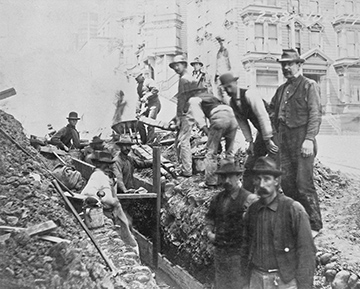
Utility workers performing underground work in San Francisco in 1900, the year IBEW Local 151 was organized. Pacific Gas & Electric
San Francisco linemen first organized a union because somebody needed their help. Linemen in Los Angeles were on strike and didn’t want linemen in San Francisco to come to Los Angeles and work as “scabs.” The San Francisco linemen had no desire to be scabs. On Oct. 11, 1900, they met at the Alcazar building on O’Farrell Street and organized their own union: International Brotherhood of Electrical Workers Local 151.
There were some 200 to 300 linemen in San Francisco, employed by telephone and electric power companies. Pacific States Telephone and Telegraph (PT&T) responded to the new union by firing ten of its employees for union activity. But IBEW 151 grew quickly. Linemen wanted the eight-hour day, a standard wage of $3 a day, overtime pay and safer working conditions. IBEW 151 President David Keefe called unionization “a matter of life and death,” noting that line work was so risky that linemen could not buy life insurance at any price.
On Dec. 1, some 200 San Francisco linemen walked off the job. They were joined by about 60 workers at various streetcar, lighting and telephone companies in Sacramento. Eleven linemen struck in Bakersfield, five in Fresno. There were efforts to organize linemen in San Jose, Oakland and Stockton.
The linemen wanted a voice in dividing up the companies’ revenues. But the tools available to the linemen were limited. There was no tradition of peaceful negotiations with utilities, and there were no labor laws requiring employers to negotiate. Other than begging, the workers’ only option was to withhold their labor.
San Francisco Gas & Electric, a predecessor of PG&E, agreed to cut the workday to eight hours. Several other small companies also accepted many of the union’s terms. One utility, the Independent Electric Light and Power Company, signed a contract that officially recognized the union and granted wage hikes, the eight-hour day, and overtime premiums. It was the IBEW’s first signed labor agreement, anywhere.